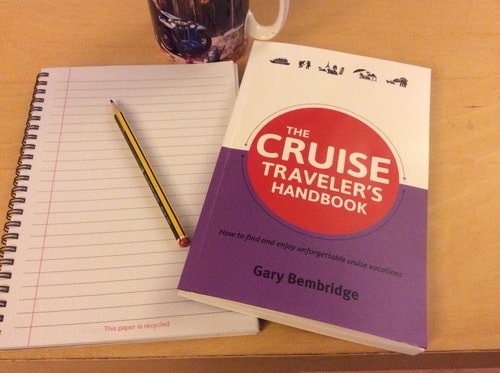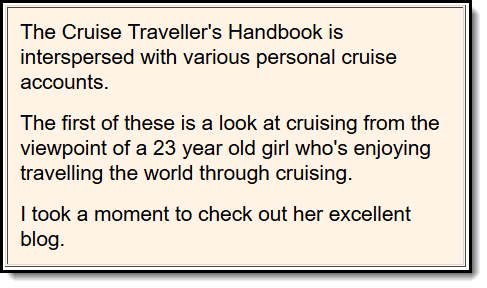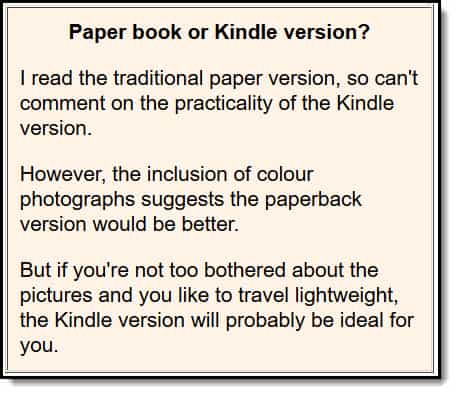As the thick padded envelope dropped through the letterbox, I knew it was going to be the eagerly awaited Cruise Traveler’s Handbook by Gary Bembridge.
From first impressions, the look and the feel of the Cruise Traveler’s Handbook spoke quality. A glossy red and purple cover protected the brilliant white pages containing clear black text and occasional colour photograph.

But looks can be deceiving, so I set to reading the actual content.
Now being a British reader, I didn’t allow what I thought was a mis-spelling of the word “traveller” to put me off. It’s simply spelt the North American way. So if you’re searching for The Cruise Traveller’s Handbook on Amazon, do remember to spell it as “Traveler” – i.e. with only one L.
The brief introduction sets out Gary’s clear love of cruising. Like many people who enjoy cruising, Gary started with a cruise he wasn’t really looking forward to.
And now having seen the world via cruises, over many years, he’s probably one of the most qualified to write such a book.
Gary sets out to dispel cruise myths by presenting realities in a snappy, interesting and informative way, and attempts to demonstrate that cruising is ideal for all groups of people – from solo travellers to special interest groups – of all ages.
The occasional little nugget throughout the book – such as the sorts of places you can get to by cruise – but that planes cannot access – indicates it’s clear he’s writing from a position of experience as well as knowledge.
I was interested to discover how Gary would present lots of facts and information, yet still keep the book interesting.
He does this with a nice balance of warm stories and accounts mixed in with facts.
It reminded me that there are places I would not have been to, had I not been on a cruise. And there are many places yet to see which cruising makes a possibility.
Discussing the ten specific groups of people to whom cruising is suited may sound a bit boring – but it’s far from that. Cruising is exciting for much more than just seniors groups.
There’s a secret to choosing the perfect cruise; it’s the one that suits your personal style. And this book helps you to get clear on that, starting with the size and type of cruise ship.
My view of cruising was quite narrow… going on a large cruise ship around the Caribbean… that sort of thing. But Gary sets out to broaden our horizons with a wide range of available cruises, including some of the more unusual and quirky – all of which are practical and enjoyable.
It was interesting to learn the pros and cons of midsized and smaller cruise ships, which can get to the tiny islands and regions otherwise unreachable.
All the major cruise companies are compared, so you’re able to get a feel of which company would best serve your personal style, whether you’re a couple, a family, or an individual… looking for luxury, action, and so on… wanting to visit a particular region of the world.
I was surprised how many different types of cruises were available – particularly the adventure and explorer cruise ships which can take you to the remotest regions such as Drake’s Passage on the way to Antarctica.
The Cruise Traveler’s Handbook itemises and discusses the cruise lines which operate the specialist (and the general) cruises.
And the amazing thing is that the book doesn’t get bogged down in unnecessary detail. It’s concise and interesting, yet informative at the same time.
In case you want to do something different from the normal cruise… as well as the ocean passenger cruise ships, there’s some great advice and information on
- Adventure and Explorer Cruise Ships
- Tall Ships
- Freighters
- Yachts
- River Cruise Ships
- Canal Barges
- Permanent Residential Ships
- Educational Ships
- Permanent Docked Cruise Ships
As I read through this section, I realised that I’d only scratched the surface of cruising. If ever I became bored with going on a large ocean cruise ship, I could go for the yacht option for a more cosy and intimate experience – or a river cruise to get closer to the towns and cities along the route.
Another thing I found useful is the listings – and the websites – of those companies which operate the various types of cruises. A valuable source of information and ideas.
After being given plenty of food for thought on cruising options, we’re presented with a look into the main cruising destinations. Personally, we’ve only experienced a handful of cruises – around the Caribbean islands, Transatlantic, Norway, and Iberia. So I was particularly looking forward to this section. And if the clarity of information so far was anything to go by, I didn’t imagine I’d be disappointed.
So was I disappointed?
No. Not at all.
Commencing with the Caribbean, I learned which are the best islands to suit us and how to get the best experience. If only we’d had this guide before we booked our first cruise.
It isn’t difficult to tell that lots of the information is written from personal experience. Tips such as ensuring your cruise to the Fjords includes villages rather than just the large towns – because “the village gives you a real sense of the region” – help you plan the ideal cruise.
If you choose the wrong cabin, it can be rather disappointing. So The Cruise Traveler’s Handbook covers choosing cabins too, starting off with descriptive overviews of the different sorts of cabin available before giving some practical advice on getting the right cabin – and the best experience from it – for the best price.
A handy budgeting section brings to light the sort of expenses to expect in addition to the cost of the cruise, and has handy tips on how to minimise or avoid these.
Some practical tips for getting the best fare deals includes one particular tip which readers of our weekly “Cruise Chat” emails will have heard me mention a few times – the importance of getting on cruise lines’ email lists so that you can receive notification of the special offers. In this section, Gary lists 6 practical tips.
There’s some useful packing advice. Now you may think that’s unnecessary. But driving to a port is so different from flying to a port – especially in the weight allowances. Some excellent guidance on checking what’s included in your contract with the cruise company too.
Knowing who is who onboard ship is very handy, especially if you need to know who to address if you have a problem. So the handy section explaining key positions and their duties is useful to keep as a reference.
If you’ve never been on a cruise, you’ll be surprised by the sorts of activities available. Gary’s provided a résumé of what’s available on a typical cruise in his “Activities, Meetings and Clubs” section.
Shore excursions are often a hot topic. Do I book with the cruise line or go independently? Or do I simply wander around on foot? The three main options for shore excursions are looked at in a practical manner. If you want to go independently, Gary gives practical advice and resources to get the best deals – and some great tips to help you choose.
Any negatives? For me, the book has one negative: There’s no index at the end of the book. Having read something in the book, an index would have been handy to help me to refer back to the relevant page later on. However, the Contents page at the front of the book is very well organised, and with a bit of scanning it’s not too difficult to stab a guess, pretty accurately, at where your topic is.
So I think you can guess I enjoyed reading the book. I did, because the book was readable. But once read, it also serves well as a reference book.
Did I think it’s worth the price? Yes. It’s packed with information, much of which is drawn from the practical experience of many years of cruising.
Being well laid out, nicely organised, and well written, I found the book interesting to read, discovered many useful tips, and learned some new information …and I’ll certainly be referring to it again when we’re planning future cruises!
It’s on Amazon in paperback and Kindle
Read personal cruise reviews from our website readers…




